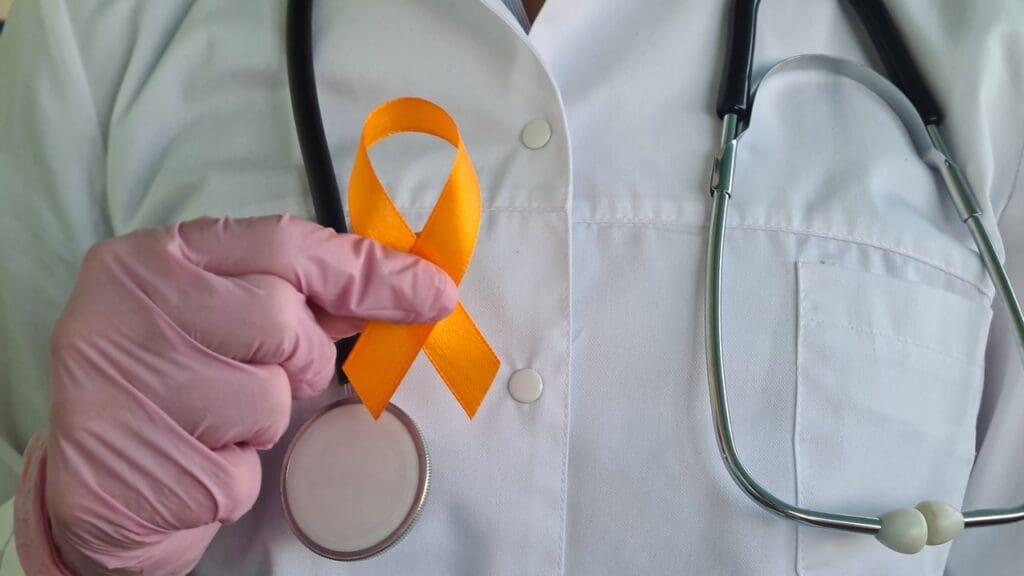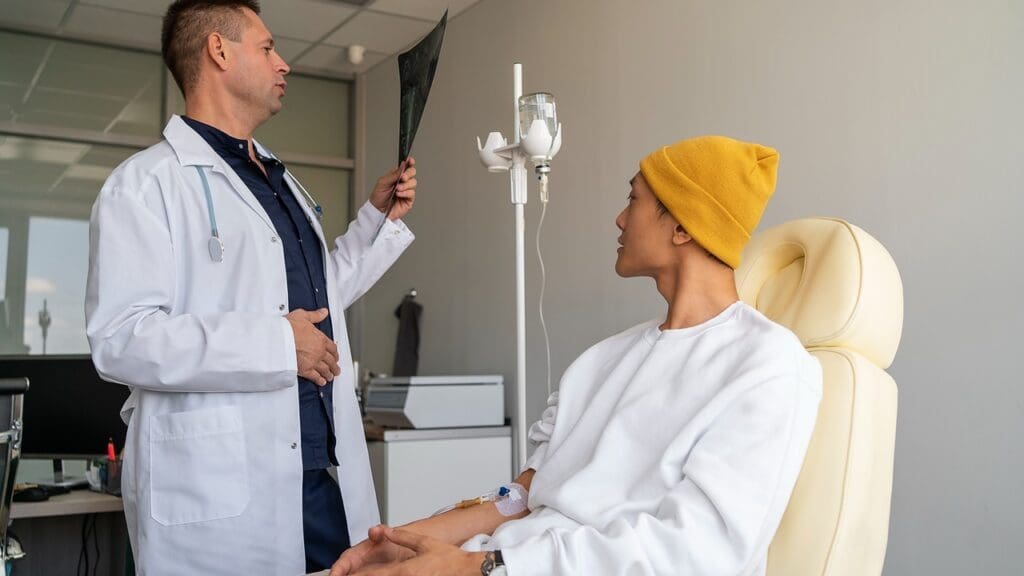Last Updated on November 27, 2025 by Bilal Hasdemir

At Liv Hospital, we understand the complexities of Acute Myeloid Leukemia (AML) treatment. Our approach to AML chemotherapy is centered around providing care that meets each patient’s unique needs.
Recent studies have shown the importance of knowing the details of chemotherapy for acute myeloid leukemia. This includes the drugs used and possible side effects. We give an overview of the treatment and what patients can expect.
Our team is committed to delivering world-class healthcare with a focus on patient care and support. By educating patients about their treatment options, we aim to improve their care and outcomes.
Key Takeaways
- Understanding the specifics of AML chemotherapy is key for patients.
- Many drugs and treatment protocols are used in leukemia chemotherapy.
- Managing side effects is a major part of AML chemo.
- Liv Hospital’s approach focuses on holistic patient care.
- Recent studies have improved our understanding of chemotherapy’s effectiveness.
- Patient education is vital for better treatment outcomes.
- Comprehensive care addresses the unique needs of each patient.
Understanding Acute Myeloid Leukemia (AML)
Acute Myeloid Leukemia (AML) is a serious type of leukemia. It happens when abnormal white blood cells grow too fast. These cells take over the bone marrow, stopping it from making healthy blood cells.
What is AML and How Does it Develop?
AML starts with a genetic change in a blood cell. This change makes too many immature white blood cells. It messes up how blood cells are made, causing a problem.
Experts say, “Changes in how cells are made can help AML grow,” showing how complex it is (Source).
Risk Factors and Prevalence in the United States
Many things can increase your chance of getting AML. These include getting older, being exposed to certain chemicals, or having had chemotherapy or radiation. In the U.S., AML is not very common. But, it’s more likely to happen to people over 65.
Knowing about these risks and AML is key for catching it early and treating it well.
The Basics of AML Chemotherapy
Chemotherapy is key in treating Acute Myeloid Leukemia (AML). It helps get rid of leukemia cells. We aim to kill the fast-growing leukemia cells and fix the bone marrow.
How Chemotherapy Targets Leukemia Cells
Chemotherapy drugs attack cells that are growing fast. Leukemia cells grow quickly, so chemotherapy is good at killing them. Cytotoxic agents harm the DNA of leukemia cells, stopping them from making more.
Goals and Expected Outcomes of Treatment
The main goal of AML chemotherapy is to get to complete remission. This means no leukemia cells are found in the bone marrow. We work hard to achieve this through different treatments.
When treatment is successful, it can greatly improve survival chances. Sometimes, it can even cure the disease.
Knowing what chemotherapy aims to do helps patients and their families understand the treatment better. It brings hope and clarity to the journey.
7 Essential Facts About AML Treatment
Acute Myeloid Leukemia (AML) treatment is complex and tailored to each patient. Knowing about AML treatment helps patients and their families understand the journey ahead.
Fact 1: Treatment is Typically Divided into Phases
AML treatment has two main phases: induction and consolidation therapy. These phases tackle the disease at different stages for complete care.
Fact 2: Induction Therapy Aims for Complete Remission
Induction therapy is the first phase. It aims to remove leukemia cells from the bone marrow. This phase is key for further treatment success.
Fact 3: Consolidation Therapy Prevents Relapse
After induction, consolidation therapy stops AML from coming back. It uses more chemotherapy to kill any remaining leukemia cells.
Fact 4: Treatment Intensity Varies by Patient
The treatment’s intensity changes based on the patient’s age, health, and leukemia type. This tailored approach improves treatment results.
Fact 5: Hospitalization is Often Required
AML treatment’s intensity often requires hospital stays, mainly during induction therapy. This ensures close monitoring and quick response to complications.
Fact 6: Treatment Duration Can Range from Months to Years
AML treatment’s length varies, from months to years. It depends on how well the patient responds and any complications.
Fact 7: Regular Monitoring and Assessment is Crucial
Regular checks and assessments are vital in AML treatment. They help doctors adjust treatment plans and quickly address new issues.
For some, stem cell transplantation is part of their treatment. It can help solidify treatment gains and aim for long-term remission.
| Treatment Phase | Goal | Typical Duration |
|---|---|---|
| Induction Therapy | Achieve complete remission | 1-2 months |
| Consolidation Therapy | Prevent relapse | Several months to years |
Common Chemotherapy Drugs for AML
Chemotherapy is key in treating AML. Several drugs are used to target leukemia cells and help patients achieve remission. The choice of drugs depends on their effectiveness in fighting the disease.
Cytarabine (Ara-C): The Backbone of AML Treatment
Cytarabine, also known as Ara-C, is a mainstay in AML treatment. It stops leukemia cells from growing by messing with their DNA. Cytarabine is used in both the initial and follow-up treatments for AML.
Anthracyclines: Daunorubicin and Idarubicin
Anthracyclines, like Daunorubicin and Idarubicin, are vital in AML treatment. They stop leukemia cells from copying their DNA. Daunorubicin is often paired with Cytarabine in a common treatment plan for AML.
Other Key Medications in AML Protocols
Other drugs are also part of AML treatment plans. For more on chemotherapy for AML, check out the American Cancer Society’s page on AML.
| Drug | Mechanism of Action | Phase of Treatment |
|---|---|---|
| Cytarabine (Ara-C) | Interferes with DNA synthesis | Induction, Consolidation |
| Daunorubicin | Intercalates DNA strands | Induction |
| Idarubicin | Intercalates DNA strands | Induction |
The drugs used are chosen based on the patient’s specific needs and AML type. This shows how important it is to tailor treatment to each patient.
Oral Chemotherapy Pills for Leukemia
Oral chemotherapy pills are becoming a key part of leukemia treatment. They offer a more convenient option than traditional intravenous chemotherapy. This change can be both good and hard for patients with Acute Myeloid Leukemia (AML).
Available Oral Options for AML Patients
AML patients have several oral chemotherapy drugs to choose from. Azacitidine and decitabine are hypomethylating agents for certain AML types. They help restore normal bone marrow function.
Benefits and Limitations of Oral Chemotherapy
Oral chemotherapy is easy to take at home, cutting down on hospital visits. But, patients must stick to their medication schedule closely. We need to think about these points when deciding on oral chemotherapy for AML patients.
Managing Side Effects of Chemo Pills
It’s key to manage oral chemotherapy side effects for patient comfort and treatment success. Side effects like nausea, fatigue, and infection risk are common. We help patients monitor and reduce these effects, aiming for the best quality of life during treatment.
Understanding and Managing AML Chemotherapy Side Effects
The journey through AML chemotherapy comes with many side effects. It’s important to know about them and how to handle them. This helps patients manage their treatment better.
Immediate Side Effects During Treatment
Patients often face immediate side effects during AML chemotherapy. These can be tough to deal with. Some common ones include:
- Nausea and Vomiting: These can be managed with special medicines.
- Fatigue: Feeling very tired that might change daily life.
- Hair Loss: It’s temporary but can be upsetting for many.
We help patients reduce these side effects. We do this through medicine and changes in lifestyle.
Long-term and Late-Occurring Side Effects
Some side effects of AML chemotherapy can last long after treatment. These include:
- Cardiac Complications: Some drugs can harm the heart.
- Secondary Cancers: There’s a small chance of getting another cancer.
- Cognitive Changes: Some patients have trouble with memory or focus.
It’s key to know about these long-term effects. This helps with ongoing care and monitoring.
Strategies to Minimize and Cope with Side Effects
Managing AML chemotherapy side effects needs a few steps. We suggest:
- Personalized Supportive Care Plans: Made just for each patient.
- Nutritional Counseling: To keep strength up and handle diet issues.
- Psychological Support: Counseling and therapy to deal with emotional effects.
Using these strategies helps patients face the challenges of AML chemotherapy. It makes their treatment experience better.
Standard Treatment Protocols for Acute Myeloid Leukemia
Acute Myeloid Leukemia (AML) treatment includes various strategies. The “7+3” induction chemotherapy regimen is a common one. It’s important for patients and healthcare providers to understand these treatments.
The “7+3” Induction Regimen Explained
The “7+3” regimen combines cytarabine (Ara-C) for 7 days with an anthracycline (like daunorubicin or idarubicin) for 3 days. This intense chemotherapy aims to kill leukemia cells and induce remission.
High-Intensity vs. Low-Intensity Approaches
How intense the treatment is depends on the patient’s age and health. Younger patients often get more intense chemotherapy. Older adults or those with health issues might get less intense treatments.
Age-Adapted Treatment Strategies
Treatment for Younger Patients
Younger patients usually get more intense chemotherapy, like the “7+3” protocol. This is to increase the chance of complete remission.
Treatment for Older Adults
Older adults might get treatments that are less intense. These focus on managing symptoms and improving their quality of life.
| Treatment Approach | Younger Patients | Older Adults |
|---|---|---|
| Intensity | High-intensity chemotherapy | Low-intensity chemotherapy |
| Goal | Achieve complete remission | Manage symptoms, improve quality of life |
| Example Regimen | “7+3” induction regimen | Less intensive protocols |
Specialized Treatment for Different AML Subtypes
Different AML subtypes need special treatments, like targeted therapies. Acute Myeloid Leukemia is a complex group of diseases. The best treatment is one that matches the patient’s leukemia’s genetic and molecular traits.
Therapy Based on Genetic and Molecular Markers
Identifying specific genetic mutations has changed AML treatment. For example, those with the FLT3 mutation might get FLT3 inhibitors. Patients with IDH1 or IDH2 mutations can get IDH inhibitors. Targeted therapy is a new, promising method. It may offer better results with fewer side effects than traditional chemotherapy.
| Genetic Marker | Targeted Therapy |
|---|---|
| FLT3 mutation | FLT3 inhibitors |
| IDH1/IDH2 mutations | IDH inhibitors |
Acute Promyelocytic Leukemia (APL) Treatment
APL is a special AML subtype with the PML-RARA fusion gene. Treatment for APL usually includes all-trans retinoic acid (ATRA) and arsenic trioxide. These treatments have greatly improved outcomes for this tough condition.
Options for Relapsed or Refractory AML
For patients with relapsed or refractory AML, new treatments are available. These include CAR-T cell therapy and other immunotherapies. Clinical trials also offer innovative treatments that might not be available elsewhere.
Stem Cell Transplantation After AML Chemotherapy
Stem cell transplantation is a possible cure for AML patients, mainly those with high-risk disease or after remission. This treatment replaces the bone marrow with healthy stem cells. It helps get rid of any leftover leukemia cells.
When Transplant is Recommended
A stem cell transplant is often suggested for AML patients at high risk of relapse. It’s also for those who have remission but might relapse without more treatment. We look at the patient’s health, genetic markers, and how they responded to first chemotherapy.
The Transplant Process and Preparation
The transplant starts with preparation. This includes chemotherapy and sometimes radiation to clear the bone marrow. Then, we give the patient healthy stem cells. These can be from a donor or the patient themselves, if saved before treatment.
Recovery and Post-Transplant Care
After the transplant, patients need close watch for signs of engraftment, infection, or graft-versus-host disease. We offer detailed post-transplant care. This includes medicines to prevent problems and help the patient recover.
Key aspects of post-transplant care include:
- Monitoring blood counts and overall health
- Managing medications to prevent graft-versus-host disease
- Preventing and treating infections
Understanding stem cell transplantation in AML treatment helps patients make informed choices. It clarifies what to expect during the process.
Supportive Care During Leukemia Chemotherapy
Supportive care is key during leukemia chemotherapy. It helps manage side effects. This care includes many services to improve patient outcomes and quality of life.
Preventing and Treating Infections
Preventing infections is vital during leukemia treatment. Patients are at high risk due to weakened immune systems. Prophylactic antibiotics and antifungal medications are used to prevent infections.
Blood Transfusions and Growth Factors
Blood transfusions are often needed to fight anemia and low platelet counts. Growth factors, like granulocyte-colony stimulating factor (G-CSF), boost white blood cell production. This lowers the risk of infections.
Nutritional and Psychological Support
Nutritional support is critical to keep patients strong and healthy. Dietary counseling helps with food choices. Psychological support, including counseling and support groups, helps with emotional challenges.
Comprehensive supportive care improves patient outcomes and quality of life during leukemia chemotherapy.
Survival Rates and Life After AML Chemotherapy
Patients often wonder about their survival rates after AML chemotherapy. They also want to know what to expect in the long term. Understanding these factors can help patients navigate their journey more effectively.
Understanding Prognosis Factors
Survival rates for AML vary based on several factors. These include age, genetic characteristics, and response to treatment. We consider these factors when assessing a patient’s prognosis.
Long-term Follow-up Care
Long-term follow-up care is key for AML survivors. Regular check-ups and monitoring help detect any relapse early. This improves outcomes.
Patient Stories and Experiences
Many patients have shared their stories of overcoming AML. Their stories provide inspiration and insights into life after chemotherapy. Their experiences highlight the importance of resilience and support.
Conclusion: Navigating the AML Treatment Journey
Dealing with AML treatment can be tough and complex. It’s key for patients to grasp the disease, treatment choices, and the role of supportive care. This knowledge helps them make smart decisions about their health.
In this article, we covered AML chemotherapy’s main points. We talked about treatment phases, common drugs, and stem cell transplants. We also stressed the need to manage side effects and offer supportive care.
For patients facing AML treatment, working with their healthcare team is vital. Understanding treatment options and the importance of leukemia care helps them deal with treatment’s challenges. This way, they can improve their chances of success.
With thorough care and support, we can help patients overcome their AML treatment journey. This approach aims to achieve the best outcomes for them.
FAQ
What is Acute Myeloid Leukemia (AML) and how is it treated?
AML is a blood and bone marrow cancer. Treatment often includes chemotherapy to kill leukemia cells. The goal is to get rid of the cancer and prevent it from coming back.
What are the phases of AML treatment?
AML treatment has three main phases. First, induction therapy tries to get rid of the cancer. Then, consolidation therapy helps keep it away. Lastly, maintenance therapy keeps the cancer from coming back.
What are the common chemotherapy drugs used to treat AML?
To treat AML, doctors use drugs like cytarabine and anthracyclines. These are often combined to target leukemia cells effectively.
What are the common side effects of AML chemotherapy?
Chemotherapy for AML can cause side effects like nausea and fatigue. It can also lead to long-term issues like heart problems and secondary cancers. Managing these side effects is key to a good outcome.
What is the “7+3” induction regimen, and how does it work?
The “7+3” regimen is a common AML treatment. It involves seven days of cytarabine and three days of an anthracycline. This combo aims to induce complete remission in AML patients.
How is treatment tailored to different AML subtypes?
Treatment for AML varies based on the disease subtype and genetic markers. For example, patients with acute promyelocytic leukemia (APL) might get different treatment than others.
What is the role of stem cell transplantation in AML treatment?
Stem cell transplantation is an option for some AML patients. It’s often used for those with high-risk disease or after chemotherapy. The process replaces the patient’s bone marrow with healthy stem cells.
How can patients manage the side effects of oral chemotherapy?
Patients on oral chemotherapy can manage side effects by following their treatment plan. Staying hydrated and reporting concerns to their healthcare team is important. Dietary changes and stress management can also help.
What is the prognosis for AML patients, and how are survival rates determined?
AML prognosis depends on factors like age, disease subtype, and treatment response. Survival rates vary. Patients should discuss their prognosis with their healthcare team.
What kind of supportive care is available for AML patients undergoing chemotherapy?
Supportive care for AML patients includes preventing infections, blood transfusions, and nutritional support. It also includes psychological support. Holistic approaches like dietary changes and stress management can be beneficial.
How long does AML chemotherapy treatment typically last?
AML chemotherapy treatment can last from months to years. It depends on the patient’s response to treatment and disease subtype.
What are the differences between high-intensity and low-intensity AML treatment approaches?
High-intensity treatment is for younger patients or those with aggressive disease. Low-intensity approaches are for older patients or those with health issues. The choice depends on the patient’s individual factors.
How is AML chemotherapy treatment adapted for older patients?
Treatment for older AML patients often uses lower-intensity regimens. The schedule may be adjusted to reduce side effects. Older patients may need more supportive care to manage health issues.
References
- American Cancer Society (ACS): https://www.cancer.org/cancer/types/acute-myeloid-leukemia/treating/chemotherapy.html
- NYU Langone Health: https://nyulangone.org/conditions/acute-myeloid-leukemia/treatments/chemotherapy-for-acute-myeloid-leukemia
- National Cancer Institute (NCI): https://www.cancer.gov/types/leukemia/patient/adult-aml-treatment-pdq
- National Center for Biotechnology Information (NCBI) / PMC: https://pmc.ncbi.nlm.nih.gov/articles/PMC10256410/







